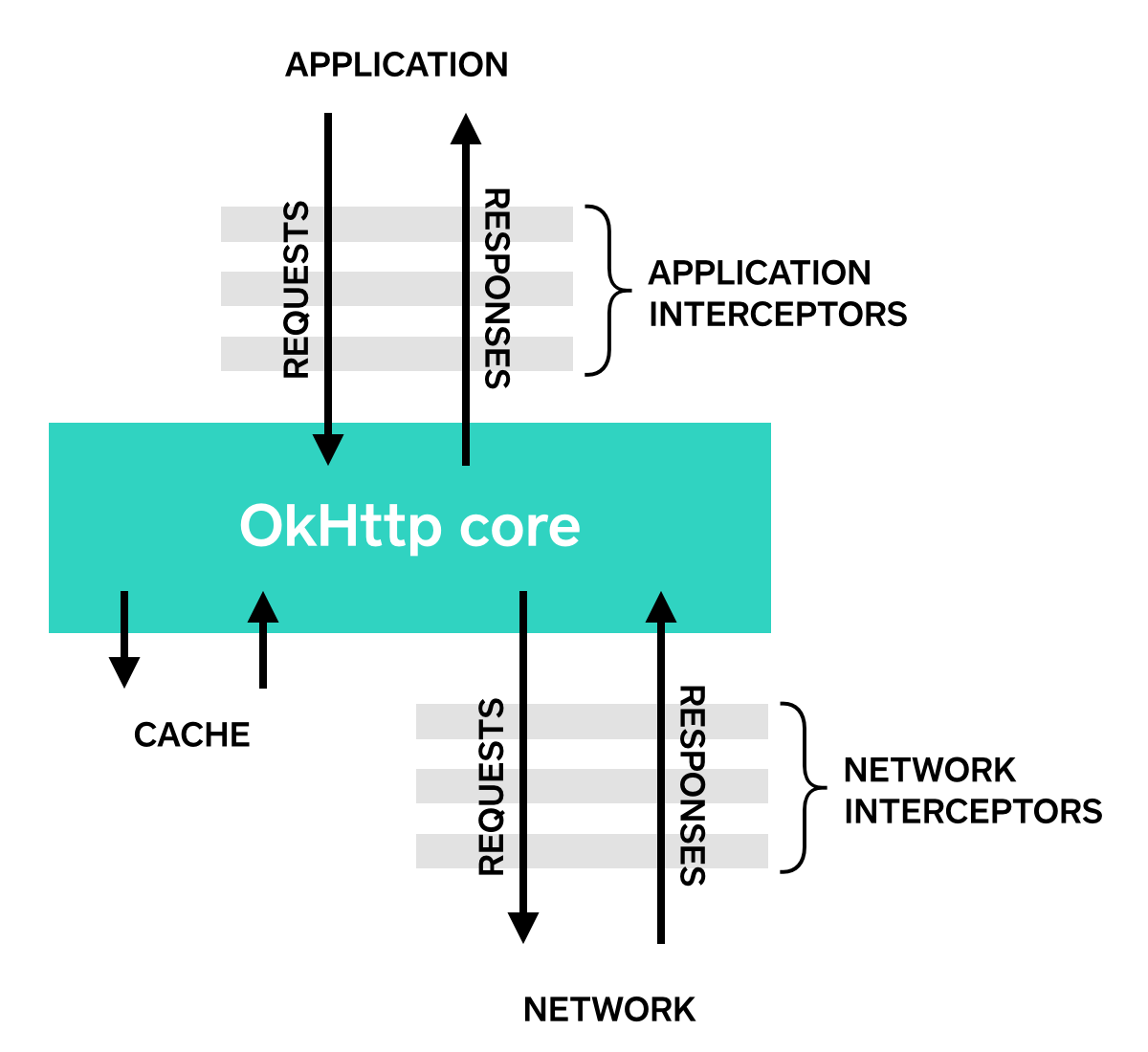根据Interceptor 分析 OkHttp(二)
来源:互联网 发布:linux mount 共享目录 编辑:程序博客网 时间:2024/06/07 17:05
根据Interceptor 分析 OkHttp(一)
根据Interceptor 分析 OkHttp(二)
为了更好的阅读体验,可以移步至根据Interceptor 分析 OkHttp(二)
Interceptor可以说是OkHttp的核心功能,它就是通过Interceptor来完成监控管理、重写和重试请求的。下面是一个简单的Interceptor,可以监控request的输入参数和response的输出内容。
class LoggingInterceptor implements Interceptor { @Override public Response intercept(Interceptor.Chain chain) throws IOException { Request request = chain.request(); long t1 = System.nanoTime(); logger.info(String.format("Sending request %s on %s%n%s", request.url(), chain.connection(), request.headers())); Response response = chain.proceed(request); long t2 = System.nanoTime(); logger.info(String.format("Received response for %s in %.1fms%n%s", response.request().url(), (t2 - t1) / 1e6d, response.headers())); return response; }}里面有个方法调用chain.proceed(request),每个Interceptor实现里都有这个调用方法,这个看起来简单的方法却是所有的HTTP请求、生成response的关键所在。
Interceptors可以被串联起来(chained)。OkHttp使用lists来管理Interceptors,让这些Interceptors按顺序被调用。

Application Interceptors
我们只能通过Application Interceptors或者Network Interceptors来注册自定义的Interceptors,其他Interceptors都是OkHttp帮你做好了的,比如RetryAndFollowUpInterceptor、BridgeInterceptor、CacheInterceptor、ConnectInterceptor、CallServerInterceptor。这里的OkHttp会启动一个拦截器调用链,拦截器递归调用之后最后返回请求的响应Response。这里的拦截器分层的思想就是借鉴的网络里的分层模型的思想。请求从最上面一层到最下一层,响应从最下一层到最上一层,每一层只负责自己的任务,对请求或响应做自己负责的那块的修改。

Application Interceptors和Network Interceptors分别位于七层模型的第一层和第六层。这个从RealCall里的getResponseWithInterceptorChain方法中就可以看出来:
Response getResponseWithInterceptorChain() throws IOException { // Build a full stack of interceptors. List<Interceptor> interceptors = new ArrayList<>(); interceptors.addAll(client.interceptors()); // Application Interceptors interceptors.add(retryAndFollowUpInterceptor); interceptors.add(new BridgeInterceptor(client.cookieJar())); interceptors.add(new CacheInterceptor(client.internalCache())); interceptors.add(new ConnectInterceptor(client)); if (!forWebSocket) { interceptors.addAll(client.networkInterceptors()); // Network Interceptors } interceptors.add(new CallServerInterceptor(forWebSocket)); Interceptor.Chain chain = new RealInterceptorChain( interceptors, null, null, null, 0, originalRequest); return chain.proceed(originalRequest); }我们通过这个LoggingInterceptor 来说明Application Interceptors和Network Interceptors的区别。
通过OkHttpClient.Builder的addInterceptor()注册一个 application interceptor:
OkHttpClient client = new OkHttpClient.Builder() .addInterceptor(new LoggingInterceptor()) .build();Request request = new Request.Builder() .url("http://www.publicobject.com/helloworld.txt") .header("User-Agent", "OkHttp Example") .build();Response response = client.newCall(request).execute();response.body().close();URL http://www.publicobject.com/helloworld.txt会重定向到https://publicobject.com/helloworld.txt,OkHttp会自动follow这次重定向。application interceptor会被调用once,并且会返回携带有重定向后的redirected response。
INFO: Sending request http://www.publicobject.com/helloworld.txt on nullUser-Agent: OkHttp ExampleINFO: Received response for https://publicobject.com/helloworld.txt in 1179.7msServer: nginx/1.4.6 (Ubuntu)Content-Type: text/plainContent-Length: 1759Connection: keep-alive我们可以看到,会重定向是因我request的URL和response的URL是不同的,日志也打印了两个不同的URLs。
Network Interceptors
注册一个Network Interceptors的方式是非常类似的,只需要将addInterceptor()替换为addNetworkInterceptor():
OkHttpClient client = new OkHttpClient.Builder() .addNetworkInterceptor(new LoggingInterceptor()) .build();Request request = new Request.Builder() .url("http://www.publicobject.com/helloworld.txt") .header("User-Agent", "OkHttp Example") .build();Response response = client.newCall(request).execute();response.body().close();当我们执行上面这段代码,这个interceptor会执行twice。一次是调用在初始的request http://www.publicobject.com/helloworld.txt,另外一次是调用在重定向后的redirect request https://publicobject.com/helloworld.txt。
INFO: Sending request http://www.publicobject.com/helloworld.txt on Connection{www.publicobject.com:80, proxy=DIRECT hostAddress=54.187.32.157 cipherSuite=none protocol=http/1.1}User-Agent: OkHttp ExampleHost: www.publicobject.comConnection: Keep-AliveAccept-Encoding: gzipINFO: Received response for http://www.publicobject.com/helloworld.txt in 115.6msServer: nginx/1.4.6 (Ubuntu)Content-Type: text/htmlContent-Length: 193Connection: keep-aliveLocation: https://publicobject.com/helloworld.txtINFO: Sending request https://publicobject.com/helloworld.txt on Connection{publicobject.com:443, proxy=DIRECT hostAddress=54.187.32.157 cipherSuite=TLS_ECDHE_RSA_WITH_AES_256_CBC_SHA protocol=http/1.1}User-Agent: OkHttp ExampleHost: publicobject.comConnection: Keep-AliveAccept-Encoding: gzipINFO: Received response for https://publicobject.com/helloworld.txt in 80.9msServer: nginx/1.4.6 (Ubuntu)Content-Type: text/plainContent-Length: 1759Connection: keep-aliveApplication and Network interceptors 该如何选择
这两个interceptor都有他们各自的优缺点:
Application Interceptors
- 不需要关心由重定向、重试请求等造成的中间response产物。
- 总会被调用一次,即使HTTP response是从缓存(cache)中获取到的。
- 关注原始的request,而不关心注入的headers,比如
If-None-Match。 - interceptor可以被取消调用,不调用
Chain.proceed()。 - interceptor可以重试和多次调用
Chain.proceed()。
Network Interceptors
- 可以操作由重定向、重试请求等造成的中间response产物。
- 如果是从缓存中获取cached responses ,导致中断了network,是不会调用这个interceptor的。
- 数据在整个network过程中都可以通过Network Interceptors监听。
- 可以获取携带了request的
Connection。
使用Interceptor的说明
在OkHttp 2.2版本才加入了Interceptor功能,而且,Interceptor不能使用OkUrlFactory,或者是基于OkHttp的低版本第三方库,比如Retrofit ≤ 1.8 and Picasso ≤ 2.4 。
- 根据Interceptor 分析 OkHttp(二)
- 根据Interceptor 分析 OkHttp(二)
- 根据Interceptor 分析 OkHttp(一)
- 根据Interceptor 分析 OkHttp(一)
- OKHttp原码分析(五)之Interceptor
- okhttp源码分析(二)-RetryAndFollowUpInterceptor过滤器
- Okhttp Logging Interceptor
- com.squareup.okhttp.Interceptor
- OKHttp 里面的Interceptor解析
- okhttp中Interceptor的使用
- android OkHttp Interceptor模拟返回
- OkHttp的拦截器Interceptor
- OKHttp源码分析(二)之RequestBody
- OKHttp源码解析(二)
- OKHttp源码解析(二)
- OKHttp源码解析(二)
- OKHttp通信使用(二)
- OKHttp源码解析(二)
- 改了好多,还有待加强
- php代码生成折现统计图
- jenkins+maven 多模块编译注意事项
- Python之一基本数据类型
- QWidget不显示的问题
- 根据Interceptor 分析 OkHttp(二)
- 引包的时候发生错误教程
- 2017.03.18【NOIP 普及组】模拟赛C组 数列 题解
- 运行mysql时,提示Table ‘performance_schema.session_variables’ doesn’t exist
- jQuery的Ajax方法注意事项
- Android单元测试(四):Mock以及Mockito的使用
- html marquee属性
- C++ 冒泡排序算法的实现与改进(含笔试面试题)
- 包含多个段的程序


